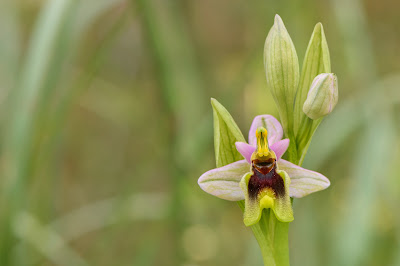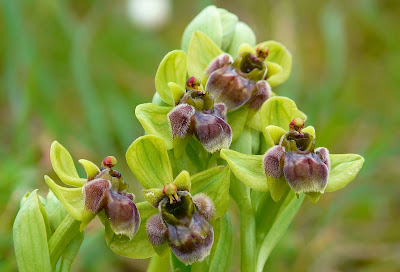Ophrys, also called as Bee orchids is found growing on calcareous soils, such as those derived from chalk and limestone which are alkaline...
Ophrys, also called as Bee orchids, Arachnites, Myodium, is a genus of the Orchidaceae family. This genus was described by Carl Linnaeus in 1753.
IDENTIFY OPHRYS - BEE ORCHIDS
Ophrys is native to Macaronesia, Europe to Caucasus, Mediterranean to Southern Turkmenistan. It is found growing on calcareous soils, such as those derived from chalk and limestone which are alkaline, relatively warm and dry, and nutrient-poor, also sometimes occur on more acidic soils in maquis or garrigue shrublands and unimproved grasslands and fallow fields, open grasslands at elevations of 0-2000 meters above sea level.
The species of this genus are mostly small terrestrial or ground orchids which are generally less than 30 cm tall with tuberous rootstock and glabrous stem. During summer, the plants are dormant as underground bulbous tubers and develop a rosette of leaves in late summer or autumn. The leaves are basal, rosulate and or cauline, unspotted. A new tuber starts to grow and matures until the following spring; the old tuber slowly dies. The next spring the flowering stem starts to grow. During flowering the leaves have already started to wither.
Bee orchids blooms in spring and summer from the lax, several floweref inflorescence. The flowers are usually showy, insectiform. Sepals sometimes reflexed, usually glabrous, green, rose-pink, or whitish. Petals glabrous or hirsute. The labellum of the flower is highly modified to lure specific species of bees or wasps with its colours, textures, and even scent.
OPHRYS - BEE ORCHIDS CARE AND CULTURE
Cultural information should only be used as a guide, and should be to be adapted to suit you. Your physical location; where you grow your plants, how much time you have to devote to their care, and many other factors, will need to be taken into account. Only then can you decide on the cultural methods that best suit you and your plants.
Light:
Ophrys receive direct morning sun in autumn in their natural habitat. As the season progresses and grasses and shrubs leaf out, the plant receive less direct sun, more dappled shade. So it is best to grow the plant in spring in direct sunlight in an eastern exposure, and once the sun progresses more directly overhead in summer, provide more shade. Once the leaves have died back in late spring, you can even put them in a shed or other protected area because they are dormant during the summer. In colder areas, the plant need to be brought indoors during the winter months and placed on a windowsill or table near a window where they will still be exposed to the winter light levels, but not to close to the window where it could get too cold.
Humidity:
Bee orchids needs the humidity level of 40-60%. Too dry air has a negative effect on the development of the plant: its growth is inhibited, and the leaves begin to turn yellow and dry out. The higher temperature, the higher the humidity should be, and the higher the humidity, the more often and longer it is necessary to ventilate the room where the plants are contained, otherwise the probability of rotting and various kinds of fungal diseases. Good air movement is essential while the plants are in leaf and growing.
Temperature:
Ophrys will tolerate the typical temperatures from -2 to 28°C providing they are given protection from frosts in winter. Ideally they should be grown in a shade-house or protected verandah position where they are protected from frosts and direct summer sun.
Substrate and growing media:
Bee orchids grow in alkaline soils, often colonising areas of disturbed soil particularly those left after building works. The plant can be successfully grown in a greenhouse or coldframe in either terracotta or plastic pots with 80% perlite, pumice or expanded clay, 20% organic components as substrate. Plants to be grown in small terracotta pots should be put into a trough of sand to ensure the tuber keeps cool and to enable watering via the sand rather than onto the rosettes. Plants in plastic pots can be sat on capillary matting which should be kept wet. Check the dampness of the pot by assessing the weight of the pot. Water the matting if the pots feel light.
The plant should be repotted in early autumn soon after the leaves have died back at the end of May. Do not delay repotting as the pseudobulbs shoot below the surface in early winter and the new shoots are easily broken during repotting. They do not like being disturbed and may not flower well for the first year after repotting. They should only be repotted after they have filled the pot or the potting mix needs replacing.
Watering:
The sand should be kept damp. As the plant begins to grow increase the watering of the sand until the tuber compost is slightly damp during the autumn growing period and again when the flower spike grows. Once the leaves have died down in autumn they should not be watered for the next 4-6 weeks and allowed to rest dry to avoid rotting the bulbs.
Fertilizer:
Ophrys doesnt need fertiliser. Many experts claim that the use of any fertilizer would ruin the natural growth of this orchid, which only needs to have humus and moisture enriched soil to thrive and flower at the right time.
Rest period:
During the mid winter period watering can be stopped. Stop fertilization in late autumn . When the new leaves have appeared in late winter watering can be resumed but only sparingly for the first few weeks as roots do not develop until about 4 weeks after the shoots appear. The surround air temperature should not be allowed to get too high and provide maximum ventilation throughout the autumn and winter. This is particularly important with the species that grow where the winters are dry and cold. Do not allow the pots to get hot and cold in mid winter.
BUY OPHRYS - BEE ORCHIDS AND RELATED PRODUCTS
BUY ANOTHERS SPECIES AND VARIETIES OF OPHRYS GENUS HERE!
SOME SPECIES OF THIS GENUS WITH CARE TIPS:
- Ophrys apifera - Bee orchid
- Ophrys bombyliflora - Bumblebee orchid
- Ophrys fuciflora - Late-spider orchid
- Ophrys fusca - Sombre bee-orchid
- Ophrys insectifera - Fly orchid
- Ophrys lutea - Yellow bee-orchid
- Ophrys reinholdii - Reinhold's ophrys
- Ophrys scolopax - Woodcock orchid
- Ophrys speculum - Mirror orchid
- Ophrys sphegodes - Early spider orchid















COMMENTS